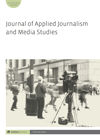
Full text loading...
 , Jacob Groshek2
, Jacob Groshek2
The Ebola virus is a rare but often severe and fatal illness in humans. It spreads from animals to humans and then transgresses through human-to-human transmission. The 2014 Ebola virus disease outbreak captured substantial media attention around the world, which is the cornerstone of our study since it can inform us about the current news coverage on the COVID-19 pandemic. This article investigates the media coverage of Ebola in five pairs of English and Arabic international television media outlets (BBC, CNN, SkyNews, RT and France24) by examining the headlines of 298,559 news stories that the respective organizations posted on their official Twitter accounts. Methodologically, we extracted headlines from news outlets that addressed the news on the Ebola virus in two languages: English and Arabic. The media outlets include the following: CNN (English and Arabic), BBC (English and Arabic), SkyNews (English and Arabic), RT (formerly known as Russia Today) (English and Arabic) and France24 (English and Arabic) from late 2013 to early 2015 during which time the Ebola epidemic intensified. We then used descriptive statistics to understand the volume of news coverage and calculate the frequencies, percentages, mean, median and standard deviations for these channels. Further, we continued to model time series regression between the five pairs of news outlets using Granger causality tests. The findings show that over the course of approximately one year’s worth of coverage on these networks, Ebola was mentioned in the headlines of 4138 stories, which constitutes 1.38 per cent of the total news coverage of all media outlets. Building on the theory of intermedia agenda-setting that outlines the ways in which major news organizations influence the agendas of other news outlets, the findings reported here indicate strong, time-ordered patterns where English-language coverage consistently precedes and helps to significantly explain the distribution of Arabic media coverage. In addition to providing evidence of intermedia agenda-setting from a comparative perspective in this context, this article expands on this theory and suggests that it can be applied to multilingual outlets from the same news organizations.

Article metrics loading...

Full text loading...
References


Data & Media loading...

Publication Date:
https://doi.org/10.1386/ajms_00073_1 Published content will be available immediately after check-out or when it is released in case of a pre-order. Please make sure to be logged in to see all available purchase options.